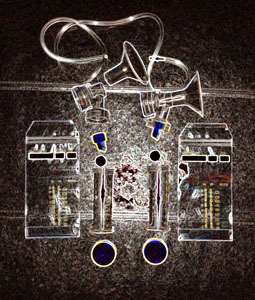Rudolph turned to her http://breastpump.org/ engineer husband, Jared Miller, to develop a new design, and Babyation was born.
+2 The Babyation shield worn on the breast, at left, shown next to a traditional breast pump. Handout
Babyation was founded while the couple lived in Connecticut but they moved to St. Louis in November after winning a $50,000 Arch Grant last year. The nonprofit Arch Grants group was founded in 2012 to fund entrepreneurial activity in St. Louis.
The amount of buy-in that people in St. Louis have shown for entrepreneurs has been incredible, Rudolph said. We had more progress here in three weeks than 18 months in Connecticut.
T-Rex offers startups like Babyation the ability to grow their business in close proximity to other startups and entrepreneurial support organizations including Arch Grants, other accelerators and a venture capital firm.
Babyation is based in the T-Rex tech incubator downtown at the Lammert Building at 911 Washington Avenue, along with 153 other businesses. T-Rex is embarking on an $8 million capital campaign to fund a renovation of the eight-story Lammert Building the nonprofit owns, said T-Rexs community director Kathleen Bauer.
lbrown@post-dispatch.com
We definitely have a product road map and plan to expand Babyation beyond breast pumps, Rudolph said. We think there are a lot of opportunities for innovation in the baby space.
Babyation, the St. Louis-based maker of a new breast pump that promises a quieter, more discreet device than existing pumps, surpassed its fundraising goal on Kickstarter and plans to ship products in March 2017.
The startup said Thursday that it raised $81,045 on the Kickstarter crowdfunding website from 427 backers after 30 days, after initially setting a $50,000 goal. The app-enabled breast pump product is available for pre-sale for $400 on the companys website, babyation.com.
Co-founder and CEO Samantha Rudolph said the Kickstarter funding will allow the company to finish the pumps design for production, with production beginning within six to nine months. Manufacturing will be in the U.S., but a site hasnt yet been selected. Our goal is to go as close to St. Louis as possible, Rudolph said.
Instead of having bottles hang from a mothers breasts during pumping, Babyations design includes a breast shield worn under a bra thats attached to thin tubing that transports breast milk to bottles.
+2 The Babyation device (in the foreground) attaches to bottles through tubing. A traditional breast pump is shown in the background. Handout
The current way creates a barrier because a mother has to remove her shirt and its very difficult to go on with your life while pumping, Rudolph said. Ours offers discretion because you dont have to remove your shirt and its lower profile.
http://www.stltoday.com/business/local/st-louis-breast-pump-startup-babyation-surpasses-kickstarter-goal/article_98513929-18ea-504c-883c-7062d9347a34.html
Rudolph, a former director of business development at ESPN, came up with the idea for a new breast pump design after reading a New York Times blog in March 2014 on the noisiness and poor design of existing pumps.

Its really a dense little city in here, Bauer said. Having that accessibility where you can bump into people and having those resources at your fingertips is important. Its that community piece thats really unique.
Lisa Brown 314-340-8127
@lisabrownstl on Twitter
















